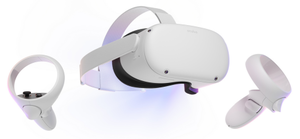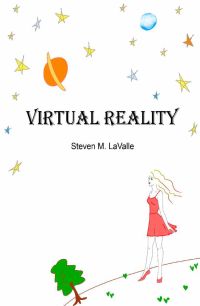CSE190S2021
Contents |
CSE 190: Virtual Reality Technology
Course Description
Virtual reality (VR) has been capturing people's imagination for decades, but it has been only recently that this technology became available for consumers. This course aims to explain how VR technology works, and you are going to do programming projects to better understand potential and limitations of today's VR hardware and devices.
Due to COVID-19 this course will be taught entirely on-line. All lectures, discussions and tutoring will happen via Zoom. You do not need to physically be in San Diego to take this course.
All lectures and discussions will be recorded and available on Canvas within 24 hours.

|

|
| Oculus Quest 2 | Oculus Quest 2 Interior |
Computer Hardware Requirements
In order to be able to do the homework projects in this course you will need to have:
- A Windows or Apple computer (desktop or laptop) with the ability to run Unity
- A VR headset with two controllers (loaner units available from CSE department)
Course Schedule
Click here for the course schedule.
It lists lecture dates, homework due dates and recommended reading.
Topics
In this course the following topics are going to be covered, plus a few more:
- Overview of the state-of-the-art VR technologies and research trends
- VR programming in Unity
- Human visual system: 3D depth cues, color perception
- Fundamental physics of 3D displays
- Display types: LCD, OLED, volumetric, light field
- How to generate stereographic 3D images
- Immersive VR systems: Head Mounted Displays, CAVE, smart phone VR, etc.
- Augmented reality devices
- Rendering to Head Mounted Displays
Prerequisites
- CSE167 (Introduction to Computer Graphics) or equivalent
Format
- Instructor: Dr. Jürgen Schulze
- Instructor's office hour: Tuesdays 2:00-3:00pm on Zoom
- TA: Guowei Yang, for lab hours see Campuswire
- Number of Units: 4
- Section ID: 40382
- Lectures: Tuesday and Thursday, 12:30pm-1:50pm on Zoom (see Canvas for URL)
- Homework Discussion: Mondays 2pm on Zoom (see Canvas for URL)
- 4 programming assignments
- Written final exam: 3 hour exam to take between June 7 at 11:30am and June 8 at 11:30am
- VR app presentation
- Discussion board: Campuswire
- Grade management: Canvas
Grading
| Project 1 | 15% |
| Project 2 | 20% |
| Project 3 | 20% |
| Project 4 | 20% |
| Final Exam | 20% |
| Presentation | 5% |
We will enter your grades into Canvas. Please verify sporadically that your grades have been recorded correctly and inform your grader or instructor if you find an error.
The final grade depends on the weighted average of all your scores. The following grading key will be used:
| Final Score | Letter Grade |
|---|---|
| 100+ | A+ |
| 95+ | A |
| 90+ | A- |
| 85+ | B+ |
| 80+ | B |
| 75+ | B- |
| 70+ | C+ |
| 65+ | C |
| 60+ | C- |
For undergraduate students with the P/NP option: A pass (P) grade will be given for an average grade of 60 or higher.
For graduate students with the S/U option: A satisfactory (S) grade will be given for an average grade of 75 or higher.
Homework Assignments
All homework projects are due on Fridays, there will be a due date roughly every other week.
- Homework Assignment #1: Whack-A-Mutant: due Sunday, April 18th at 11:59pm
- Homework Assignment #2: Characterizing VR Systems: due Sunday, May 2nd at 11:59pm
- Homework Assignment #3: Levels of Immersion: due Sunday, May 23rd at 11:59pm (no late deadline)
- Homework Assignment #4: CAVE Simulator: due Sunday, June 6th at 11:59pm
All projects are solo projects. Team work is not permitted.
To submit your project, make a video of your app showcasing all its features and upload it to Canvas by the due date.
Unless indicated otherwise, if you cannot get a project done in time before the due date you can submit it 7 days later with a penalty of 25% of your score.
Internet Resources
UCSD's VR Club TritonXR has some excellent resources to help you get started creating VR applications with Unity.
- Workshop Slides: Take a look at the "Technical" folder for Unity-specific workshops. If you're interested, there are also non-technical design slides that are interesting for VR.
- Unity Tutorial Guide This guide helps you navigate Unity's many offered tutorials.
EdX course 190x teaches VR with Unity on smartphones with lots of videos and hands-on tutorials. You can audit it free of charge.
Or you can view just the tutorial videos which walk you through the steps to create a VR app for your smartphone.
Run your Quest 2 without a Facebook account (requires an old Oculus account).
Useful information on quaternions
Textbooks
You will not need to buy a textbook for this course because the lecture slides will be made available to you, and the material from the lectures will be sufficient for the final exam. However, if you want more in-depth information, we recommend the following books:

|
The VR Book by Jason Jerald, 550 pages, Morgan & Claypool Publishers, October 16, 2015, ISBN-10: 1970001127, ISBN-13: 978-1970001129 |

|
Virtual Reality by Steven M. LaValle. To be published by Cambridge University Press. Download PDF |
Students with Disabilities
If you have a documented disability, please email me your documentation to me as soon as possible so that I can make suitable accommodations for you. If you believe that you have a disability and desire accommodation, please register with the Office for Students with Disabilities.